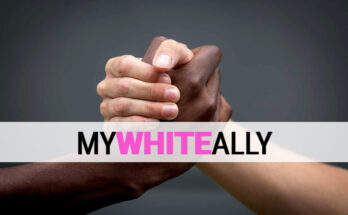by Allison Gaines | Medium
I am certain that at one point or another most white people in America (and sadly many confused people of color) have thought: Why can’t they just stop talking about race and racism?
But, we won’t and we can’t stop talking about race and its very real impacts on the bodies and lives of People of Color. Those of us who have been brought up in schools of critical thought and who were raised to understand that to be silent is to be complicit, we see it as our ethical and moral obligation to keep “bringing up the race card” because it is our duty and responsibility to be disrupters of injustice.
For those naysayers who want us trouble-makers to be quiet, I want to share concrete and documented examples of how race and racism continue to harm society. The following are some of the top reasons why we’ll keep talking about race across all of the spaces and places we live, work, eat, pray, and love. These examples speak to the profound way race and racism continue to plague our society and why we can’t and won’t stop bringing up racism.
1. School-to-Prison Pipeline
The school to prison pipeline for those of you who might not know is “a disturbing national trend wherein children are funneled out of public schools and into the juvenile and criminal justice systems” (ACLU).
Did you know that “Black Americans are incarcerated in state prisons across the country at nearly five times the rate of whites, and Latinx people are 1.3 times as likely to be incarcerated than non-Latinx whites” and “nationally, one in 81 Black adults in the U.S. is serving time in state prison?” (The Color of Justice report)
It has been well researched that the pipeline to prison for men of color starts at an early age and disproportionately impacts low-income and urban communities.
2. Police Brutality

We will never forget the senseless and brutal murder of George Floyd (and the countless others) by a merciless white police officer and his accomplices who watched and allowed this unforgivable incident to happen.
As we remember George Floyd and witness justice prevail in his case, it is vital for us to remember that there have been thousands upon thousands of incidents of violence committed by the police against people of color that have gone unseen, dismissed, and largely tolerated. These incidents have not stopped.
“The rate of fatal police shootings among Black Americans was much higher than that for any other ethnicity, standing at 38 fatal shootings per million of the population as of January 2022.”
Although many well-intentioned people have forgotten their words and commitments now more than a year past the moment of “racial reckoning,” we will continue to say their names loudly, hold their families in our hearts, and demand justice.
3. Education is Still Unequal
More than six decades after the momentous decision made in Brown v. Board of Education, we still have a largely inequitable education system that continues to provide greater opportunities to whites. This trend is exacerbated as you move up the educational ladder, meaning that discrepancies become starker in higher education.
Although there has been a continued decrease in the racial gap across graduation rates, education is far from equal. Anyone of us who attended large urban schools with majority students of color can share first-person accounts of how our education was lacking except for the occasional inspiring teacher.
“40% of white students earned at least a bachelor’s degree in 2019, while only 18.8% of Hispanic/Latinx students did, according to the Census Bureau.” (UCDA)
“The New York Times, which reports more than 50% of schoolchildren in the U.S. are in racially concentrated districts. Some districts are also segregated by income.” (UCDA)
Only 31.5% of Bachelor’s degrees were earned by people of color.
“Minority graduate students remain substantially underrepresented in graduate education, particularly in STEM fields.” (CGS)
4. People of Color Get Paid Less
This is true regardless of education attained and income level. Take the following fact from a report that analyzed the pay differences across race:
“On average, Black men earned 87 cents for every dollar a white man earned. Hispanic workers had the next largest gap, earning 91 cents for every dollar earned by white men. On the other side of the earnings spectrum, Asian men typically earned $1.15 for every dollar earned by a white male worker.”
And for women, it’s worse:
“Women were paid just 80 cents for every dollar paid to their male counterparts. But the wage gap was even larger when looking specifically at Black women who work full time, year-round — they were paid only 63 cents for every dollar paid to white, non-Hispanic men.”
5. Extreme Wealth Disparities

I learned a long time ago that wealth is where you see the major inequities across race. If you thought income was inequitable, when you look at wealth indicators such as savings, retirement, investment portfolios, etc. those inequities are shocking.
“The wealth gap between Black and white Americans has been persistent and extreme. It represents, scholars say, the accumulated effects of four centuries of institutional and systemic racism and bears major responsibility for disparities in income, health, education, and opportunity that continue to this day.” (The Harvard Gazette)
Here are a couple of other statistics from this article:
“As of the end of 2020 the homeownership rate for Black families stood at about 44 percent, compared with 75 percent for white families, according to the Census Bureau.”
“The typical white American family has roughly 10 times as much wealth as the typical African American family and the typical Latino family. In other words, while the median white household has about $100,000-$200,000 net worth, Blacks and Latinos have $10,000-$20,000 net worth.”
6. Major Health Disparities Between Whites and People of Color
Not only do people of color have to deal with inferior education systems, racial profiling, and stark wealth inequities, but the U.S. continues to have major racial disparities as far as health coverage, health conditions, and in mortality rates.
Numerous studies over decades have shown that people of color fare far worse than their white counterparts across various measures and indicators of health status.
“Recent data from before the COVID-19 pandemic showed that people of color fared worse compared to their white counterparts across a range of health measures, including infant mortality, pregnancy-related deaths, prevalence of chronic conditions, and overall physical and mental health status. As of 2018, life expectancy among Black people was four years lower than White people, with the lowest expectancy among Black men.” (KFF.org)
7. Environmental racism continues to disproportionately impact People of Color

Dr. Robert Bullard, a renowned scholar and activist, defines environmental racism as “any policy, practice or directive that differentially affects or disadvantages (where intended or unintended) individuals, groups or communities based on race.”
What does this mean on the day-to-day? It means that People of Color will continue to endure an unequal and inequitable amount of environmental toxins and pollutions in comparison to whites (read this blog). In fact, race, more than zip code or any other variable, continues to be the greatest predictor of one’s exposure to environmental harms.
“Three out of five African Americans live in communities with uncontrolled toxic waste sites.” (NCCJ.org)
It is shameful to know that communities of color continue to be disproportionately sited for toxic industries that results in greater exposure to air pollution and other hazards and subsequently results in a greater impact to their health and well-being.
8. People of Color Most Impacted by Climate Change
It has been well documented that People of Color are and will be most harmed and impacted by climate change and most will and do not have the same resources as whites to deal with the short and long term effects of climate change.
“Climate change is affecting all of us. But, like many other challenges in society, it’s hurting communities of color the most.” (Forbes).
“Communities of color breathe in 40 percent more polluted air than White communities across the US, according to the NAACP’s 2012 Coal-Blooded study.”
“Racial minorities in the United States will bear a disproportionate burden of the negative health and environmental impacts from a warming planet, the Environmental Protection Agency said Thursday, including more deaths from extreme heat and property loss from flooding in the wake of sea-level rise.” (The Washington Post)
…
After reading these present-day examples of how race and racism continue to impact the daily lives of Black, Indigenous, and People of Color across the nation (and globe), it is my hope that next time there’s a courageous person who brings up race in your meeting, class, dinner, etc., that instead of shutting them out or down, you will remember that society is far from treating everyone equitably. In fact, society continues to harm, deter, and impact people largely based on their race.
It is important to note that these discrepancies are reflective of historic (and intentional) inequities that continue across all societal systems in the US — from economics, to housing, to healthcare, to education, to the legal system, etc.
It would be easy to point the finger and blame the very people who are facing inequities but the reason we won’t stop talking about race and throwing the supposed “race card” is because the legacy of making inequity a systemic practice continues strong across the US.
Until the day when we are able to research every social sector and report equity across every single societal measure, then maybe we’ll stop talking about race and racism.
Click here to view original web page at allyfromnola.medium.com







